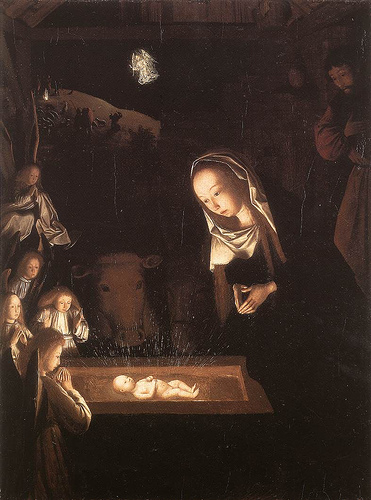Today is the shortest and darkest day of the year, as well as the Sunday before Christmas, so this week’s picture is an appropriately nocturnal depiction of the baby Jesus in his crib: the Nativity at Night, painted some time between 1480 and 1490 by an artist from Leyden called Geertgen tot Sint Jans. A dark but touchingly intimate depiction of Christ’s nativity, portable if not quite pocket-sized, it was almost certainly intended for private devotional use. Despite areas of paint loss and slightly obtrusive restoration (the face of the kneeling angel on the extreme left has clearly been repainted by a later hand) it is one of my favourite pictures in the National Gallery.
My earliest memory of this painting is not of actually seeing it but of reading about it in the school library, in Erwin Panofsky’s Early Netherlandish Painting. Panofsky made the startling claim that Geertgen’s little picture was “the earliest nocturne”. While one or two painters before him had attempted to create the illusion of night, none apparently had dared to represent its true darkness as Geertgen did here. This was therefore “the first empirical and systematic account of the optical conditions prevailing in a picture space exclusively illumined by non-solar sources located within it.”
But as Panofsky also observed, it would be wrong to admire Geertgen’s little picture as a masterpiece of naturalism. It is after all a religious painting. Its effects are calculated to accentuate the contrast between the real and the supernatural – between the ordinary lights that might be seen after dark on any ordinary occasion, and the two bursts of supernatural radiance that illumine this particular, miraculous night. The crackling fire that warms the shepherds on the wintry hilltop in the distance is outshone by the claritas dei diffused...


